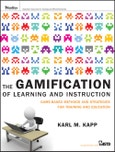"Kapp argues convincingly that gamification is not just about adding points, levels and badges to an eLearning program, but about fundamentally rethinking learning design. He has put together a brilliant primer for learning professionals on how to gamify learning, packed with useful advice and examples." ?ANDERS GRONSTEDT, president, Gronstedt Group
"After reading this book, you'll never be able to design boring learning again." ?CONNIE MALAMED, author, Visual Language For Designers; author/creator of The eLearning Coach Blog
"Engaging, informative and complete; if you need to understand anything about instructional game design, this is the book you need. It provides the right amount of academic evidence, practical advice and insightful design tips to have you creating impactful learning in no time." ?SHERRY ENGEL, associate director learning technology, Penn Medicine Center for Innovation and Learning
"What Karl Kapp has done with this book is looked at games and learning from every possible angle....he provocatively asks questions that the learning community needs to answer, like 'Do our design processes still work?' and 'Are we really meeting the needs of today's learners?' This book may make you anxious, make you laugh, or make you angry. But one thing it will definitely do is make you think." ?RICH MESCH, experiential learning guru, Performance Development Group
Table of Contents
List of Figures and Tables xii
Contents on the Web xv
Foreword by Kevin Kruse xvii
Preface xxi
Acknowledgments xxvii
About the Author xxix
Contributors xxxi
Chapter 1 What Is Gamification? 1
Chapter Questions 1
Introduction 2
Gamification in Action 2
What Is a Game? 6
What Is Gamification? 9
What Gamification Is Not 12
Gamification Versus Serious Games 15
Growth of Gamification 18
Who Is Using Gamification 19
Implications and Importance to the Future of Learning 22
Key Takeaways 23
Chapter 2 It’s in the Game: Understanding Game Elements 25
Chapter Questions 25
Introduction 26
Abstractions of Concepts and Reality 26
Goals 28
Rules 29
Conflict, Competition, or Cooperation 31
Time 32
Reward Structures 33
Feedback 35
Levels 37
Storytelling 41
Curve of Interest 45
Aesthetics 46
Replay or Do Over 48
Implications and Importance to the Future of Learning 49
Key Takeaways 50
Chapter 3 Theories Behind Gamification of Learning and Instruction 51
Chapter Questions 51
Introduction 51
Motivation 52
The Taxonomy of Intrinsic Motivation 58
Self-Determination Theory 63
Distributed Practice 65
Scaffolding 66
Episodic Memory 67
Cognitive Apprenticeship 69
Social Learning Theory 70
Flow 71
Key Takeaways 74
Chapter 4 Research Says . . . Games Are Effective for Learning 75
Chapter Questions 75
Introduction 76
Game Research 76
Randel’s Meta-Analysis 77
Wolfe’s Meta-Analysis 80
Hays’ Meta-Analysis 80
Vogel’s Meta-Analysis 82
Ke’s Qualitative Meta-Analysis 83
Sitzmann’s Meta-Analysis 85
Elements of Games 88
Key Takeaways 101
Chapter 5 Leveling Up: What Gamification Can Do 105
Chapter Questions 105
Introduction 106
Improving Surgeon Hand-Eye Coordination 106
Solving Problems 108
Teaching Higher Order Skills 110
Thinking the Unthinkable 112
Thinking Like Your Opponent 113
Engaging Learners in a Live Classroom 115
Helping People Lose Weight 116
Making Physical Therapy More Enjoyable 119
Influencing Pro-Social Behavior 119
Testing Knowledge and Performance 123
Good for Young and Old 125
Key Takeaways 126
Chapter 6 Achiever or Killer? Player Types and Game Patterns 127
Chapter Questions 127
Introduction 128
Types of Play 128
Player Skill Levels 131
Bartle’s Player Types 132
Caillois’ Patterns of Play 137
Game Interactions 141
Key Takeaways 142
Chapter 7 Applying Gamification to Problem Solving 143
Chapter Questions 143
Introduction 144
Differences Between Novices and Experts 145
Turning Novices into Experts 147
Preparing Firefighters 158
Gamification of Problem Solving 161
Key Takeaways 164
Chapter 8 Applying Gamification to Learning Domains 165
Chapter Questions 165
Introduction 166
Declarative Knowledge 167
Conceptual Knowledge 171
Rules-Based Knowledge 177
Procedural Knowledge 181
Soft Skills 185
Affective Domain 185
Psychomotor Domain 187
Key Takeaways 190
Chapter 9 Managing the Gamification Design Process 193
Chapter Questions 193
Introduction 194
Development Process: ADDIE vs. Scrum 195
Team 202
Design Document 205
Paper Prototyping 216
Key Takeaways 217
Chapter 10 Congratulations! Selecting the Right In-Game Achievements, by Lucas Blair 219
Chapter Questions 219
Introduction 220
Measurement vs. Completion Achievements 220
Boring vs. Interesting Tasks 222
Achievement Difficulty 223
Goal Orientation 224
Expected vs. Unexpected Achievements 225
When Achievement Notification Occurs 227
Achievement Permanence 228
Who Can See Earned Achievements? 229
Negative Achievements 230
Achievements as Currency 231
Incremental and Meta Achievements 232
Competitive Achievements 233
Non-Competitive Cooperative Achievements 235
Key Takeaways 236
Chapter 11 Perspective of a Gamer, by Nathan Kapp 239
Chapter Questions 239
Introduction 240
Gamer Generation 240
Mario Kart: Thinking Outside the Box 240
Madden Football: Analyzing Problems 241
RuneScape: The Art of the Deal 243
Civilization Revolution: Balancing Resources 244
Games vs. School 245
Key Takeaways 246
Chapter 12 Casual Game Site: DAU Case Study, by Alicia Sanchez 247
Chapter Questions 247
Introduction 248
Games and Simulations in the Curriculum 248
DAU Casual Games Initiative 249
Games Portal 254
Key Takeaways 255
Chapter 13 Alternate Reality Games for Corporate Learning, by Koreen Olbrish 257
Chapter Questions 257
Introduction 258
Zombie Apocalypse 258
What Is an ARG? 259
ARG Terminology 260
Design Principles for ARGs 261
Potential of ARGs 263
Key Takeaways 264
Chapter 14 If You Want to Learn More, Play Games 265
Chapter Questions 265
Introduction 266
Pick a Card, Any Card - A Game of Phones 266
Survival Master 271
The Virtue of Gamification 274
Next Steps 275
Key Takeaways 276
Glossary 277
Notes 285
Index 297








